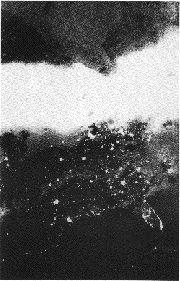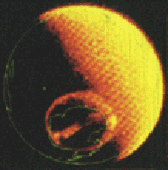
Scientific Imagers in Space
The Canadian scientific satellite Isis-2 (1971) carried an auroral imaging camera and discovered the diffuse aurora, a broad ribbon around the auroral oval, too spread-out to be noticed from the ground. This aurora is probably formed by electrons which leak out of the ends of field lines threading the plasma sheet.
More comprehensive observations of the aurora from above were carried out (1981 - 1987) by the Dynamics Explorer 1 (DE-1) satellite which moved in an elongated polar orbit rising to 4.65 RE. Several modes of operation were used; some pictures were taken in the greenish oxygen "line" (emitted at the precise wavelength of 5577 angstrom) which usually dominates the aurora's appearance from the ground, but many used the ultra-violet. The typical time resolution was 2-12 minutes, enough to resolve the phases of a substorm but not finer details.
Later auroral imagers included Sweden's "Viking" (in 1986) and "
Freja." Currently, NASA's Polar (1996) collects images of the polar aurora using three cameras--in visible light (sometimes as frequently as 12 seconds apart), in ultra-violet and in x-rays.
Theta Aurora

DE also studied a special class of auroras (mapped earlier by Isis 2), aligned not with the auroral oval but sticking out from it, into the dark interior around the magnetic pole, generally aligned with the sunward direction. They occur at quieter times, away from substorms. The DE imaging camera found that at times such arcs extended completely across the oval, bridging the dark space from the night side to the day side. The global pattern then resembled the Greek letter theta, a circle with a bar across its middle (Θ), and this form was therefore named the "theta aurora." No good explanation exists as yet for either sunward arcs or the theta aurora.
The Speed of Auroral Motions
While satellite imagers view the aurora from above, TV cameras are
nowadays used to watch it from below, a narrower view than the one from space
but a more detailed one. To the eye the aurora appears quite sluggish, its rays slowly brightening and fading. However, the slowness is not in the aurora but in the light emission process of the green line of oxygen, which usually
provides most of the auroral light seen from the ground. An oxygen atom energized by the collision of an auroral electron may not emit this light promptly, but only after a delay, typically close to a second.
Sensitive TV cameras can filter out that light and view the aurora in other
emissions, fainter but responding much more promptly. The resulting
pictures show more details and change quite rapidly.
Questions from Users:
***
Skywriting by Aurora?
|

